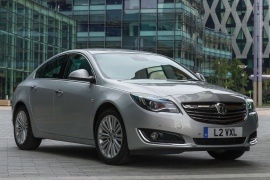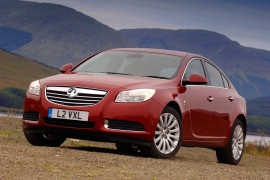VAUXHALL Insignia Sedan Models/Series Timeline, Specifications & Photos
First production year: 2008
Engines: Diesel, Gasoline
Vauxhall went through some rough times during the world financial crisis and tried to get back on its feet when it introduced the facelifted version of the Insignia lineup in 2013.
Even though its pockets were still bleeding money and the sales were not where they were supposed to be to save the brand, Vauxhall had to refresh the Insignia's lineup. So, that's what it did, and the Sedan was the version that should bring the biggest sales from the lineup. Thus, besides improving on the car's exterior, the British automaker also upgraded the cabin and the engine lineup, working together with its European partner Opel.
At the front, the car sported high gloss black with embedded chrome accents, creating a sportier look for the vehicle. In addition, depending on the trim level, the Insignia Sedan featured bi-xenon headlights and LED daytime running lights. The upper grille was adorned by three v-shaped chromed slats and a wider one above them that sported the brand's badge. On the sides, the front doors sported the same downward sculptured line that created, in conjunction with the car's rounded roofline, the image of a larger cabin. At the back, the sloped-down windscreen continued on the short trunk lid, while finally, at the back, the redesigned taillights sported dark-tinted lenses.
Inside, the most significant upgrade for the 2013 Insignia was the center stack. There, Vauxhall offered an option for a large touchscreen placed between the center vents. In addition, the front occupants of the car enjoyed the sports seats designed together with AGR (Action Gesunder Rucken), a company specializing in making healthier products for peoples' backs. At the back, the automaker installed a split-folding bench seat suitable for two people on long journeys.
Under the hood, Vauxhall installed a range of turbocharged gasoline and diesel engines paired with six-speed manual or automatics, depending on the options. Power went at the front axle or in all corners, depending on the customers' choice.
The 2008 Vauxhall Insignia was revealed at the 2008 London Motor show and it was an important change from the aging Vectra. The car-maker didn't only change the name, it shifted the direction.
Vauxhall needed a larger car than the Vectra. It was needed to offer more interior room. But it didn't want to use the Vectra anymore. It was time to move on and so, it did it with the new Insignia. A car that offered more than a Vectra and came with a clean sheet design that was far from what the medium-sized Vauxhalls were before.
At the time of its launch, the Insignia was offered in two body versions: a hatchback and a classic, three-box sedan. The sloped rear of the later made it look like a hatch, but the trunk lid was opened independently from the rear window. The sculptured side panels and doors visually increased the length of the car. The headlights were aggressive and featured daytime running lights. All the efforts of the designers toward the aerodynamics paid off with a spectacular Cd of 0.27.
The interior was build from scratch and not even the previously used materials didn't found a place to be used. The front seat seatbacks were thicker by 2 cm (0.8”), offering softer support for their occupants. The rear knee room was bigger by 3 cm (1.2”) than of the outgoing Vectra. A new infotainment generation included a seven-inch color monitor, with 3-D map view, digital travel guide and improved scroll and zoom functions.
The 2008 Vauxhall Insignia featured a wide range of engines, from a small 1.6-liter gasoline unit up to a 2.8-liter V6 unit. For the diesel fans, it offered three versions of a 2.0-liter turbodiesel. Front or all-wheel-drive systems were available for selected versions.

